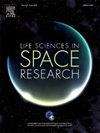Impact of gravitational forces on Red Blood Cell dynamics in biofluid suspension
IF 2.8
3区 生物学
Q2 ASTRONOMY & ASTROPHYSICS
引用次数: 0
Abstract
The growing interest in space exploration and human spaceflight has highlighted the critical challenges posed by microgravity on human physiology. Among these, a significant issue is space anemia, which adversely affects Red Blood Cells (RBC) and alters its behavior. RBC depends on biofluids, for their systemic transport, a process that experiences disruption in the microgravity environment. This study aims to quantitatively address the puzzle of how red blood cells are influenced by gravity when they are suspended in bio-fluid. Dissipative Particle Dynamics (DPD) approach was used to model blood and the cell by applying gravity as an external force along the vertical axis and varied from 0g to 2g during parameter sweeps. Key metrics, including Elongation and Deformation indices, pitch angle, and normalized center of mass, were utilized to assess cellular behavior. Results revealed that gravity induces shape changes and spatial alignment in red blood cells. The Elongation Index and the normalized center of mass declined linearly with the applied gravity. Correlation analysis showed a strong correlation between applied gravity and the aforementioned variables. Additionally, forces acting on the cell, such as drag, shear stress, and solid forces, diminished as gravitational force increased. Further analysis indicates that increasing gravity affected the cell’s velocity, resulting in prolonged proximity to vessel walls and intensified viscous interactions with surrounding fluid particles, thereby triggering morphological changes. This study provides crucial insights into the biophysical effects of gravity on the red blood cell and presents a significant step toward understanding cellular dynamics under altered gravitational conditions.
生物流体悬浮液中重力对红细胞动力学的影响
人们对空间探索和载人航天的兴趣日益浓厚,这凸显了微重力对人体生理构成的严峻挑战。其中,一个重要的问题是空间贫血,它对红细胞(RBC)产生不利影响并改变其行为。红细胞依靠生物体液进行全身运输,这一过程在微重力环境下会受到破坏。这项研究旨在定量地解决红细胞悬浮在生物液体中是如何受到重力影响的难题。耗散粒子动力学(DPD)方法通过施加重力作为沿垂直轴的外力来模拟血液和细胞,在参数扫描期间从0g到2g不等。关键指标,包括伸长率和变形指数,俯仰角和标准化质心,被用来评估细胞的行为。结果表明,重力诱导红细胞的形状变化和空间排列。伸长率和归一化质心随重力的增加呈线性下降。相关分析表明,施加重力与上述变量之间存在较强的相关性。此外,作用在电池上的力,如阻力、剪切应力和固体力,随着重力的增加而减小。进一步分析表明,重力的增加影响了细胞的速度,导致细胞与血管壁的距离延长,与周围流体颗粒的粘性相互作用加剧,从而引发形态变化。这项研究为了解重力对红细胞的生物物理影响提供了重要的见解,并为理解改变重力条件下的细胞动力学迈出了重要的一步。
本文章由计算机程序翻译,如有差异,请以英文原文为准。
求助全文
约1分钟内获得全文
求助全文
来源期刊

Life Sciences in Space Research
Agricultural and Biological Sciences-Agricultural and Biological Sciences (miscellaneous)
CiteScore
5.30
自引率
8.00%
发文量
69
期刊介绍:
Life Sciences in Space Research publishes high quality original research and review articles in areas previously covered by the Life Sciences section of COSPAR''s other society journal Advances in Space Research.
Life Sciences in Space Research features an editorial team of top scientists in the space radiation field and guarantees a fast turnaround time from submission to editorial decision.
 求助内容:
求助内容: 应助结果提醒方式:
应助结果提醒方式:


